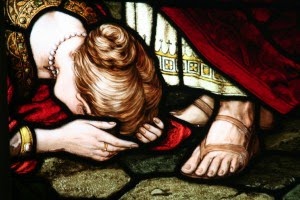 |
| Michelangelo Last Supper |
Throughout
Luke-Acts extensive use is made of the banquet motif as a means to throw light
on:
·
The nature of the eschatological community
· Who is to participate in the messianic banquet
·
The universal nature of salvation
Within the Jewish tradition the metaphor of the banquet was
already familiar
·
Isa 25:6-9 The eschatological banquet
·
Isa 55:1-3 The invitation to hear and be saved
·
Prov 9:1-6 Wisdom’s banquet.
During the intertestamental period the banquet theme was
related to the coming messiah. The positive universalism of Isa 25:6-9 came to
be displaced by an increasingly exclusive approach which would bar Gentiles
from the messianic banquet ( cf Bailey ) 1 Enoch 62:1-16, Aramaic Targums on Isa
25:6. In time even the lame, blind,
deaf, dumb and those in any way imperfect would come to be excluded 1 Qsa
2:11-22. Such attitudes are clearly unacceptable for both Jesus and his
disciples Luke 5:27-32 cf Matt 9:9-13, Mark 2:13-17.
Luke
7:33-35 sets the scene for the second banquet Luke 7:36-50. Here Luke is at
pains to point out that the woman who anoints Jesus is a sinner vss 37,39,48,49
cf Matt 26:6-13//Mark 14:3-9. The addition of the parable of the two debtors
provides a filter for the through which sinners are to be seen.
In Luke
11:37-52 Jesus once again dines with a Pharisee which provides the opportunity
for some value clarification. As Jesus travels towards Jerusalem Israel’s
complacency regarding its place at
the messianic banquet in the kingdom of
God is shown to be misplaced Luke13:22-30.
The banquet
theme is once again picked up in Luke 14 where Luke’s audience is challenged
regarding their:
·
Charity 14:1-6
·
Humility 14:7-11
·
Generosity 14:12-14
These are the attitudes which enable one to take part in the
messianic banquet. The parable of the great banquet Luke 14:15-24 reminds
Luke’s audience that
·
The eschatological banquet is already prepared
·
It will be extended to those seen to be
outsiders in Israel
·
It will be extended to those outside Israel.
 |
| Rembrandt - Hermitage Museum |
Luke’s account of the last supper
Luke 22:14-38 reinforces elements of Luke 14 regarding:
·
Humility and service Luke 14: 7-13 Luke 22:24-27 cf Luke 12:35-37
·
Reward Luke 14:14 Luke 22:28-30.
The last banquet scene of the gospel is that of the road to
Emmaus Luke 24:14-35. Now it is the Risen Lord who partakes in table fellowship
(a crucial concern for the Christian understanding of the breaking of the bread
). It is within the eucharist that the identity and mission of Jesus is
revealed. The hints made regarding the
extension of the messianic banquet to Gentiles in Luke 13:28-30; 14:23 are
fulfilled in Acts. The Jerusalem community which breaks bread in Acts 2:42 will
come to accept table fellowship with Gentiles Acts 10:23, 48; 11:3,18;
15:19-20; 16:34.


No comments:
Post a Comment